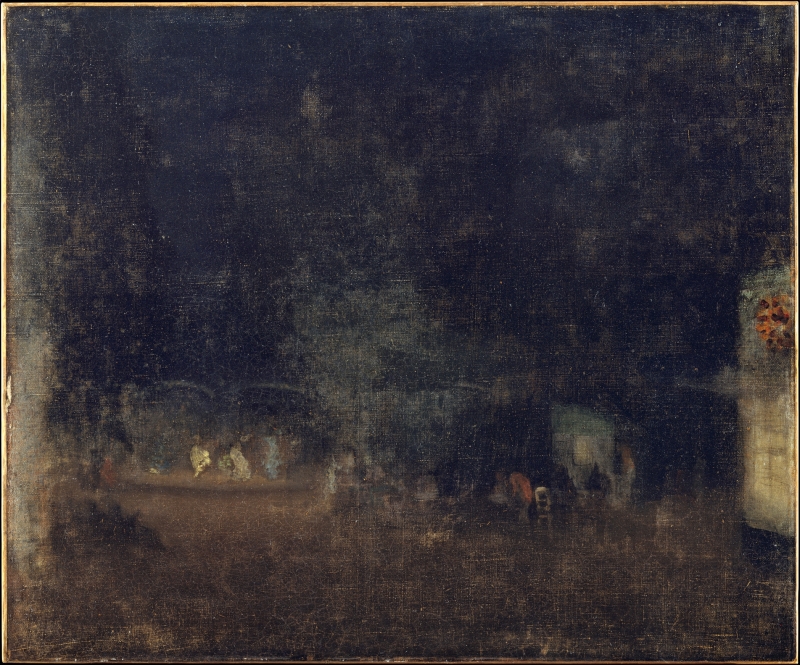Provenance
- 1886/1892: acquired by Charles Benjamin Bright McLaren (1st Lord Aberconway) (1850-1934) .
- By 1902: Théodore Duret (1838-1927) , Paris;
- 1902: sold through Agnew's to Magda Stuart Sindici (Mrs W. Heinemann) (b. 1878, m. 1899) , in May 1902;
- 1903: sold to Edmund Davis (1861-1939) , London, in November 1903, and repurchased in February 1904;
- 1905: sold by Mrs Heinemann through Agnew's, London art dealers, to Winaretta Singer, Princesse Edmond de Polignac (1865-1943) , in February 1905;
- 1906: bought through P. Mathey, Paris, by Walter Gay (1856-1937), Paris;
- 1906: sold by Gay to the Metropolitan Museum of Art, New York (gift of Harris Charles Fahnestock (1835-1914)).
It was probably the 'Nocturne - [Cremorne] Dancing', listed by Whistler in 1886 or 1887 as owned by 'McLaren'; it is not certain when he sold it, nor when Duret bought it. 1 According to Agnew, the art dealer, 'I had the picture from Monsieur Duret with the advice of Whistler himself, who always looked on this Nocturne as one of his finest works.' 2 It was bought by Mrs William Heinemann (wife of the publisher) in May 1902; she sold it to Edmund Davis in November 1903, repurchased it in February of the following year, and sold it – again through Agnew's – to the Princesse Edmond de Polignac in February 1905. 3 Within a year it was sold again, this time through P. Mathey to Walter Gay (1856-1937), and by Gay to the Metropolitan Museum of Art. In recommending it, Gay wrote that he thought the picture 'a little black, but that is the fault of a good many Whistlers, but they are so hard to find, and so few of them of any importance.' 4 Presumably he meant that some paintings still in private hands were not 'of any importance'!
Exhibitions
- 1905: Memorial Exhibition of the Works of the late James McNeill Whistler, First President of The International Society of Sculptors, Painters and Gravers, New Gallery, Regent Street, London, 1905 (cat. no. 62) as 'Nocturne in Green and Gold, The Falling Rocket' lent by W. Heinemann.
Whistler mentioned 'Nocturne - Cremorne' to D. C. Thomson in May 1892, describing it as 'The large one that was sent down to Bond Street but not exhibited', meaning that it was not included in his retrospective exhibition, Nocturnes, Marines & Chevalet Pieces, Goupil Gallery, London, 1892. 5
It is not certain that this refers to Nocturne in Black and Gold: The Gardens [YMSM 166], which was the second largest of the known Cremorne paintings, but it is known that it had conservation issues, and the same letter asks Thomson to send it to his picture restorer.
The largest of the Cremorne Nocturnes was Cremorne Gardens, No. 2 [YMSM 164], but Whistler did not know where it was at this time, and it was not the biggest in terms of height, but in width and area. Next in size were Nocturne in Black and Gold: The Gardens [YMSM 166], Nocturne: Black and Gold - The Fire Wheel [YMSM 169] (which was in the Goupil 1892 show), Cremorne, No. 1 [YMSM 163], Nocturne: Cremorne Gardens, No. 3 [YMSM 165], and (the smallest but most famous) Nocturne in Black and Gold: The Falling Rocket [YMSM 170]. 6
Notes:
1: [1886/1887], formerly dated [4/11 January 1892], GUW #06795.
2: Quoted by Walter Gay in a letter to the Metropolitan Museum of Art, 22 March 1906, Museum Archives, D. Dwyer, painting conservator, Metropolitan Museum of Art, 21 March 1983; Spassky, Natalie, with Linda Bantel, Doreen Bolger Burke, Meg Perlman, and Amy L. Walsh, American Paintings in The Metropolitan Museum of Art, vol. 2, A Catalogue of Works by Artists Born between 1816 and 1845 , New York, 1985, p. 372.
3: Agnew's a/c #481, 1033, 1133, 1632.
4: Walter Gay to the Metropolitan Museum of Art, 28 February 1906, Museum Archives; quoted in Spassky 1985, op. cit., p. 372.
6: Their sizes are as follows: 68.5 x 135.5 cm; 63.8 x 77.2 cm; 54.3 x 76.2 cm; 49.5 x 76.2 cm; 44.9 x 63.1; 60.3 x 46.6 cm. The area of each is 9281.75, 4925.36, 4137.66, 3771.9, 2833.19, and 2809.98 square cm.
Last updated: 19th April 2021 by Margaret





